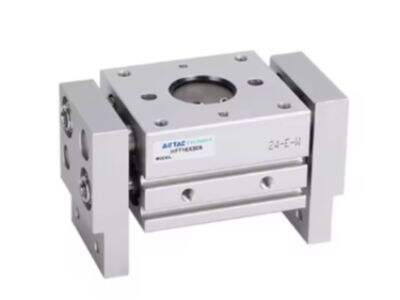Ви е ли кога ли се чудили какво правят някои от най-тежкото трудещите се машини в големи фабрични сгради? Това е наистина интересно. Пневматичните актуатори, които са ключов компонент на тези машини. Какво са пневматичните актуатори - може да кажете, че са като мускулите в телата ни. Подобно на мускулите и начинът, по който ни помагат да се движим и да извършваме задачи, пневматичните актуатори помагат на машините да се движат бързо и да изпълняват функциите си ефективно. Този текст ще ви научи за пневматичните актуатори, ролята им в фабричните процеси, как те помогат на машините да работят ефективно, и 5 обикновени приложения, които ги срещаме всеки ден.
5 Приложения на пневматични актуатори в фабрики
Има различни машини, които използваме всеки ден и които съдържат пневматични актуатори. Например, те позволяват на автомобилите да управляват важни компоненти като тормозите и вратите. Те също така помагат за движение на заклопите на самолетните крила и на посадителните шasi, които поддържат безопасната посадка. Освен това, пневматичните актуатори се използват в роботите, за да ги направят да работят гладко. В фабриките тези актуатори изпълняват множество функции, като повдигане на тежки предмети, активиране на машинни компоненти и също се използват за контролиране на движението на течности, които се използват в определени приложения.
Използване на пневматични актуатори за бързо работещи машини
Ето защо пневматичните актуатори са станали изборът по подразбиране за фабрики, бързи и надеждни. Актуаторът може да бъде поставен в движение много бързо, когато машина трябва да се движи. Скоростта е важна, тъй като помага на фабриките да изпращат увеличен обем производство за по- kratko време. За опериране на пневматичните актуатори се използва compr essed въздух. Compressed въздухът е въздух, силно compr essed в по-малко пространство, който е изключително мощен. Актуаторите могат да преместват много натоварване и работят в тежки условия при по-лоши от идеалните условия.
5 типични приложения на пневматични актуатори
Монтажни линии – Пневматичните актуатори помогат на работниците в фабриките да преместват и разграждат различни части точно и с много висока скорост. Тези актуатори допринасят за бързото преместване на компонентите им на техния правилен положение, значително ускорявайки процеса на монтажа. Тази част е важна, тъй като помага на фабриката да произвежда повече статии ефективно.
Тест на аккумулятора на дроселното тяло: дроселният актуатор е още един ключов компонент, използван в упакователните механизми с пневматични актуатори. Те помагат при бутилването на течности, задържането на упаковките стиснато и маркирането на стоките. Актуаторите позволяват бързо и прецизно движение на упаковачните материали, което води до по-бърза обща работа на машината и по-голяма производителност. Това е важно за удовлетворяване на заявк
Роботи – Пневматичните актуатори също се включват в роботите, използвани в различни индустрии. Те се използват, за да помогнат на роботите с движението и да извършват процеси като взимане на части, сваряне на метални парчета и дори боядисване на кола. Пневматичните актуатори имат висока прецизност и бърза реакция, което прави роботите в фабриките много ефективни.
Обработка на материали — Актуаторите са значителна част от машините, които помагат при преместването на тежки материали като кутии, съдове и възли. Те могат да вземат тези предмети и да ги пренасят на други точки в фабриката. Това позволява на работниците да спестяват време и енергия, които биха изхарчили, ако пренасяха тежките предмети самолично. То помога за поддържане на безопасна и ефективна работна среда.
Системи за ОВК: Пневматичните актуатори, използвани в системите за кондициониране и отопление, регулират потока на въздуха и топлината през сградата. Системата може да отваря и затваря вентилите и клаповете, за да балансира температурата между стаите. Това е много важно, защото предпазва жителите на сградата, както и служителите и клиентите, от неудобства.
Използване на пневматични актуатори за автоматизация на фабрики
Пневматичните актуатори играят ключова роля в автоматизирането на фабрики. Това означава, че машините изпълняват задачи, които преди това бяха извършвани от хора. Това позволява на фабриките да минимизират времето и грешките. Пневматичните актуатори помагат на машините да извършват задачи като събиране, упаковка и транспортиране на материали. Този вид автоматизация помога на производителите да произвеждат масовно по-ефективно, което е полезно от бизнесна гледна точка.
5 фактора за надеждността на пневматичните актуатори в фабриките
Прочност: Пневматичните актуатори са конструирани от металургически компоненти, които могат да издържат много големи наляганания. Те са създадени да оцелят в тежки условия като висока температура, прах и вибрации в рамките на производствено помещение. Благодарение на тази прочност, те не се разпадат бързо.
Без електричество -> Тези актуатори са много надежни, тъй като не се питаят от електричество. Това означава, че те не представляват опасност от пожар, което е изключително важно за места, където могат да се срещат горими газове или прах. Работниците са в безопасност в фабриката при използването на такива пневматични актуатори.
Пневматичните актуатори също имат висока надеждност. Те са по-малко склонни към повреди поради по-малко движими части в сравнение с електродвигателите. Това е важно, тъй като гарантира, че машините продължават да работят и няма забавяния в производството.
Пневматичните актуатори имат скоростта навърху списъка си от качества. Те могат бързо да се адаптират на промени в машините, от които са част. Това им позволява да прехвърлят части и материали по-бързо, отколкото човек може, което е критично за спазване на производствените графици.
Четвърто, пневматичните актуатори са икономични. Те имат ниско обслужване и по-дългогодишна жизнь. Това може да спести пари на фабриката, тъй като не трябва да бъдат заменяни толкова често, колкото електродвигателите. Те също изискват по-малко енергия за работа, което ги прави умни бизнес граждани.


